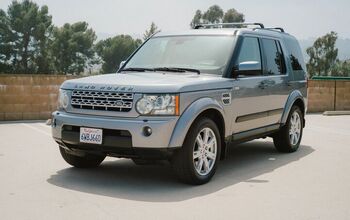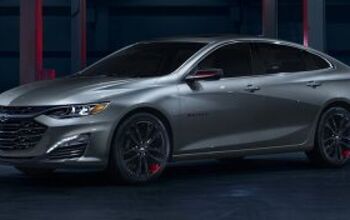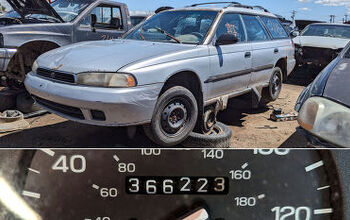2021 Land Rover Defender 90 First Edition Review – Expensive Capability

The last time I reviewed a Land Rover Defender, I commented on how I enjoyed its driving experience despite some very British electrical failings such as the radio going AWOL for half an hour.
I expected similar from the two-door version, and to my pleasant surprise, I got the good parts without any real gremlins or bugs.
2021 Land Rover Defender 90 First Edition Fast Facts
I even had a chance to go off-road, and I found the two-door Defender to be quite capable in the backwoods of an off-road park in Indiana.
Not that the experience was perfect – after all, nothing is. I returned from the woods with some scratched-up paint. More on that in a second.
This Defender had a 3.0-liter inline-six underhood – and it’s a mild hybrid setup. Here, the six has a turbocharger and a 48-volt electric supercharger, and a belt-integrated starter motor replaces the alternator. A 48-volt lithium-ion stores energy that’s captured under braking. An eight-speed automatic transmission with a twin-speed transfer case gets the power to the wheels – the Defender has a permanent four-wheel-drive system.
The mild-hybrid setup was so seamless that I forgot the Defender had a mild-hybrid until later perusing the spec sheet. With 395 horsepower and 406 lb-ft of torque, there’s enough power on tap to feel good about passing and merging.
Like the bigger four-door sibling, this Defender also had steering that was surprisingly well-tuned for on-road driving, and an on-road ride that rarely offended. The shorter wheelbase did occasionally make the ride a bit worse, predictably, though not by much. I credit the air suspension here – though I concede that Land Rover air suspensions have a reputation for breaking and being costly to fix – which such expensive breakage naturally only occurring after one’s warranty has expired.
Then again, if you have the scratch to be shopping for Land Rovers, paying for these repairs might not cause you too much stress.
The real fun came in the boonies. The Defender has a system that can sense the terrain and adjust accordingly, a center-locking diff (a rear locker is available), and the requisite drive modes. All these factors combined to help me traverse narrow trails with relative ease. I also managed to get across a muddy patch of woods without getting stuck or smacking a tree – though some moments were tense – to access an open field where I could goose the gas and get the rear end a bit loose.
I also managed to climb a medium-sized, somewhat challenging rock pile with ease.
No stuckies? No bent sheetmetal? Success, right? Well, upon leaving the park I found the pretty Pangea Green was quite easily pockmarked by thin tree branches that lean into the trails and brush up against any vehicle that’s passing by. Those same tree branches didn’t leave any evidence of their existence behind on the Wrangler I’d tested, or the Bronco Sport (which doesn’t carry such premium paint), so it was a bummer to see an off-road-ready vehicle taking cosmetic damage. I am told the fix was easy – it actually did buff right out – but I’d warn any Defender intenders to think about paint protection before going to the backwoods.
Indeed, Land Rover does make a big deal of the Defender’s ability to ford up to 34.5 inches of water, and its maximum suspension articulation of 19.7 inches. It’s too bad the paint got marred so easily.
Just like with the four-door version, I generally found the interior to be attractive with a decent user experience, though pushing knobs to switch between the controls for various functions gets annoying and occasionally stymies one’s attempt to do something quickly. I also shudder at how expensive it will be to replace the digital screens outside of warranty. At least Land Rover’s haptic touch controls are about as good as haptic touch can be – and yes, that is damning with faint praise.
My test rig based at $64,100 and came with 20-inch wheels, front jump seat, front fog lamps, LED headlights, rearview-mirror camera, navigation, Apple CarPlay, Android Auto, satellite radio, blind-spot assist, lane-keep assist, premium audio, rubber interior materials for easy cleaning after off-roading, and traffic-sign recognition. Options were limited to a tow-hitch receiver and off-road tires that surely helped a bit at the Badlands.
Total as-tested? $66,475.
I can’t help it – I dig the Defender, regardless of door count. That’s not to say it’s perfect – the electrical gremlins of the first one I tested are fresh in my mind nearly two years later. The interior’s UX is fancy for the sake of fancy – the brand could’ve easily avoided haptic touch and kept things simple. But overall, the packaging here is good, the off-road chops legitimate, and the on-road ride surprisingly excellent.
Perhaps the proper Brit – flawed yet charming, and capable of facing challenges without much complaint.
What’s New for 2021?
The Defender came back to the market for the 2021 model year, and save for the First Edition packaging, it carries into 2022 and 2023 with only minor changes.
Who Should Buy It
The well-heeled adventurer who wants an SUV with good on-road manners and stout off-road capability.

Tim Healey grew up around the auto-parts business and has always had a love for cars — his parents joke his first word was “‘Vette”. Despite this, he wanted to pursue a career in sports writing but he ended up falling semi-accidentally into the automotive-journalism industry, first at Consumer Guide Automotive and later at Web2Carz.com. He also worked as an industry analyst at Mintel Group and freelanced for About.com, CarFax, Vehix.com, High Gear Media, Torque News, FutureCar.com, Cars.com, among others, and of course Vertical Scope sites such as AutoGuide.com, Off-Road.com, and HybridCars.com. He’s an urbanite and as such, doesn’t need a daily driver, but if he had one, it would be compact, sporty, and have a manual transmission.
More by Tim Healey
Latest Car Reviews
Read moreLatest Product Reviews
Read moreRecent Comments
- Bd2 Lexus is just a higher trim package Toyota. ^^
- Tassos ONLY consider CIvics or Corollas, in their segment. NO DAMNED Hyundais, Kias, Nissans or esp Mitsus. Not even a Pretend-BMW Mazda. They may look cute but they SUCK.I always recommend Corollas to friends of mine who are not auto enthusiasts, even tho I never owed one, and owned a Civic Hatch 5 speed 1992 for 25 years. MANY follow my advice and are VERY happy. ALmost all are women.friends who believe they are auto enthusiasts would not listen to me anyway, and would never buy a Toyota. They are damned fools, on both counts.
- Tassos since Oct 2016 I drive a 2007 E320 Bluetec and since April 2017 also a 2008 E320 Bluetec.Now I am in my summer palace deep in the Eurozone until end October and drive the 2008.Changing the considerable oils (10 quarts synthetic) twice cost me 80 and 70 euros. Same changes in the US on the 2007 cost me $219 at the dealers and $120 at Firestone.Changing the air filter cost 30 Euros, with labor, and there are two such filters (engine and cabin), and changing the fuel filter only 50 euros, while in the US they asked for... $400. You can safely bet I declined and told them what to do with their gold-plated filter. And when I changed it in Europe, I looked at the old one and it was clean as a whistle.A set of Continentals tires, installed etc, 300 EurosI can't remember anything else for the 2008. For the 2007, a brand new set of manual rec'd tires at Discount Tire with free rotations for life used up the $500 allowance the dealer gave me when I bought it (tires only had 5000 miles left on them then)So, as you can see, I spent less than even if I owned a Lexus instead, and probably less than all these poor devils here that brag about their alleged low cost Datsun-Mitsus and Hyundai-Kias.And that's THETRUTHABOUTCARS. My Cars,
- NJRide These are the Q1 Luxury division salesAudi 44,226Acura 30,373BMW 84,475Genesis 14,777Mercedes 66,000Lexus 78,471Infiniti 13,904Volvo 30,000*Tesla (maybe not luxury but relevant): 125,000?Lincoln 24,894Cadillac 35,451So Cadillac is now stuck as a second-tier player with names like Volvo. Even German 3rd wheel Audi is outselling them. Where to gain sales?Surprisingly a decline of Tesla could boost Cadillac EVs. Tesla sort of is now in the old Buick-Mercury upper middle of the market. If lets say the market stays the same, but another 15-20% leave Tesla I could see some going for a Caddy EV or hybrid, but is the division ready to meet them?In terms of the mainstream luxury brands, Lexus is probably a better benchmark than BMW. Lexus is basically doing a modern interpretation of what Cadillac/upscale Olds/Buick used to completely dominate. But Lexus' only downfall is the lack of emotion, something Cadillac at least used to be good at. The Escalade still has far more styling and brand ID than most of Lexus. So match Lexus' quality but out-do them on comfort and styling. Yes a lot of Lexus buyers may be Toyota or import loyal but there are a lot who are former GM buyers who would "come home" for a better product.In fact, that by and large is the Big 3's problem. In the 80s and 90s they would try to win back "import intenders" and this at least slowed the market share erosion. I feel like around 2000 they gave this up and resorted to a ton of gimmicks before the bankruptcies. So they have dropped from 66% to 37% of the market in a quarter century. Sure they have scaled down their presence and for the last 14 years preserved profit. But in the largest, most prosperous market in the world they are not leading. I mean who would think the Koreans could take almost 10% of the market? But they did because they built and structured products people wanted. (I also think the excess reliance on overseas assembly by the Big 3 hurts them vs more import brands building in US). But the domestics should really be at 60% of their home market and the fact that they are not speaks volumes. Cadillac should not be losing 2-1 to Lexus and BMW.
- Tassos Not my favorite Eldorados. Too much cowbell (fins), the gauges look poor for such an expensive car, the interior has too many shiny bits but does not scream "flagship luxury", and the white on red leather or whatever is rather loud for this car, while it might work in a Corvette. But do not despair, a couple more years and the exterior designs (at least) will sober up, the cowbells will be more discreet and the long, low and wide 60s designs are not far away. If only the interiors would be fit for the price point, and especially a few acres of real wood that also looked real.







































Comments
Join the conversation
God I want one. This thing is cool. And therein lies the problem. JLR makes such achingly seductive SUV's that will leave you stranded on the highway at 11pm in the rain. I've been seduced twice, it ended badly, but I'm not going to rule out bending over and grabbing my ankles again for Land Rover a third time.
Such a beautiful SUV always love the styling. Sorry to say I'll stick with Toyota cause of the great reliability!